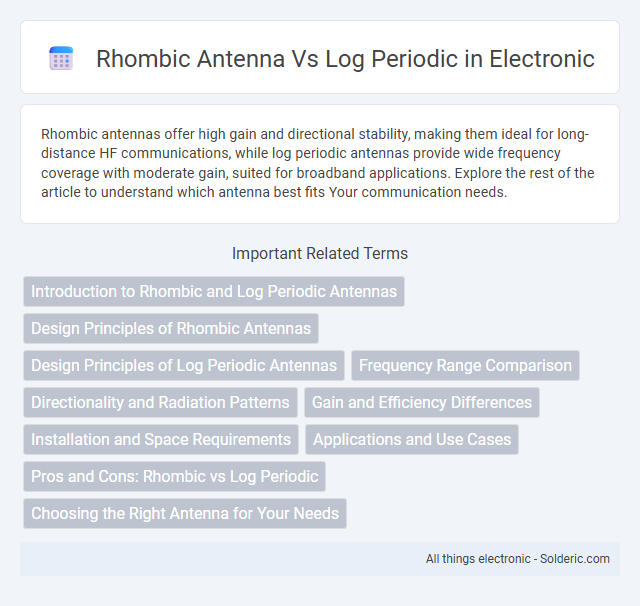Rhombic antennas offer high gain and directional stability, making them ideal for long-distance HF communications, while log periodic antennas provide wide frequency coverage with moderate gain, suited for broadband applications. Explore the rest of the article to understand which antenna best fits Your communication needs.
Comparison Table
| Feature | Rhombic Antenna | Log Periodic Antenna |
|---|---|---|
| Design | Large, diamond-shaped wire antenna | Array of dipole elements with logarithmic length spacing |
| Frequency Range | Narrow to moderate bandwidth | Wide bandwidth, typically 2:1 or more |
| Gain | High gain (up to 20 dBi) | Moderate gain (6 to 10 dBi) |
| Directivity | Highly directional | Directional, less than rhombic |
| Size | Very large, requires significant space | Compact compared to rhombic |
| Polarization | Horizontal or vertical | Horizontal or vertical |
| Applications | Long-distance HF communication, skywave propagation | Wideband HF/VHF communication, direction finding |
| Impedance | Variable, typically 300-600 O | Stable 50-300 O |
| Construction Complexity | Simple wire structure but large setup | Moderate, multiple elements and support |
Introduction to Rhombic and Log Periodic Antennas
Rhombic antennas feature a simple wire design, offering high gain and directional capabilities ideal for long-distance HF communication. Log periodic antennas consist of multiple elements with varying lengths and spacings, providing wide bandwidth and consistent radiation patterns across a broad frequency range. Both antennas serve distinct purposes in radio transmission, with rhombic excels in fixed, high-gain applications, while log periodic antennas support frequency agility and broad-spectrum use.
Design Principles of Rhombic Antennas
Rhombic antennas utilize a diamond-shaped wire configuration designed for high-gain, directional radiation patterns with wide bandwidth capabilities. Their design principles rely on length and angle optimization to maximize signal strength and minimize side lobes, making them ideal for long-distance HF communications. Unlike log periodic antennas that use multiple elements with varying lengths to cover broad frequency ranges, rhombic antennas achieve performance through geometric symmetry and ground reflections.
Design Principles of Log Periodic Antennas
Log periodic antennas employ a series of dipole elements with gradually varying lengths and spacing, enabling consistent impedance and radiation patterns over a broad frequency range. Unlike the large, fixed-geometry rhombic antenna optimized for a narrow band, log periodic designs achieve wideband performance through their self-similar structure and frequency-scaled elements. Your choice of a log periodic antenna supports versatile applications requiring stable gain and directivity across multiple frequencies.
Frequency Range Comparison
The rhombic antenna typically operates efficiently within the high-frequency (HF) range from 3 to 30 MHz, providing directional gain over a narrow bandwidth. In contrast, the log periodic antenna covers a much broader frequency range, often spanning from 100 MHz up to several GHz, making it suitable for applications requiring wideband performance. Your choice between these antennas depends on whether you need focused, long-distance HF communication or versatile coverage across multiple frequency bands.
Directionality and Radiation Patterns
Rhombic antennas exhibit highly directional radiation patterns with narrow beamwidth, making them ideal for long-distance point-to-point communication by focusing energy in specific directions. Log periodic antennas provide broader directional coverage with multiple lobes and relatively consistent radiation patterns across a wide frequency range, offering versatility in multi-frequency applications. The rhombic antenna's unidirectional gain contrasts with the log periodic's moderate gain and frequency-stable performance, impacting their suitability for fixed versus broadband directional targeting.
Gain and Efficiency Differences
Rhombic antennas generally offer higher gain, typically between 7 to 15 dBi, making them ideal for long-distance HF communications with improved directivity. Log periodic antennas provide moderate gain, around 5 to 8 dBi, but excel in broadband frequency coverage and consistent radiation efficiency across multiple frequencies. Your choice depends on whether maximum gain or frequency versatility is more critical for your application.
Installation and Space Requirements
A rhombic antenna requires a large, open space for installation due to its extensive wire length and support structures, often spanning hundreds of feet, making it less suitable for confined areas. In contrast, a log periodic antenna is more compact and easier to install, fitting into tighter spaces with a smaller footprint while still offering broad frequency coverage. Your choice depends on available land and installation convenience, with log periodic antennas favored for limited space and rhombic antennas for high-gain, directional needs over wide areas.
Applications and Use Cases
Rhombic antennas excel in high-frequency HF skywave propagation applications, including long-distance point-to-point communication, international broadcasting, and shortwave listening due to their high gain and directional characteristics. Log periodic antennas are widely used in VHF/UHF frequency ranges for applications such as television reception, radio direction finding, and wideband communication systems because of their broad frequency coverage and consistent impedance. Both antenna types are favored in scientific research, military communications, and amateur radio, where frequency agility and directional control are crucial.
Pros and Cons: Rhombic vs Log Periodic
Rhombic antennas offer high gain and wide bandwidth, making them ideal for long-distance HF communications but require large land area and are directional with fixed main lobes. Log periodic antennas provide broad frequency coverage and adjustable directionality with smaller size, suited for applications needing multi-band performance. However, log periodic antennas typically have lower gain and more complex design compared to the simpler and more efficient rhombic antennas at very high frequencies.
Choosing the Right Antenna for Your Needs
Rhombic antennas offer high gain and directional performance ideal for long-distance shortwave communication, while log periodic antennas provide a wide frequency range and moderate gain suitable for versatile, multi-band use. Selecting between them depends on specific needs such as bandwidth requirements, directionality, and installation space. Consider rhombic antennas for fixed, high-efficiency, point-to-point links, whereas log periodic antennas excel in applications requiring frequency agility and broader coverage.
rhombic antenna vs log periodic Infographic

 solderic.com
solderic.com